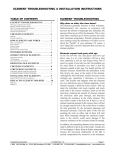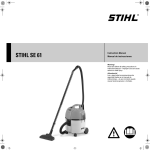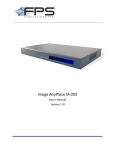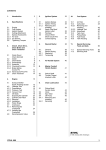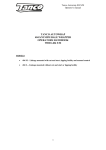Download Stihl Saw Chain Care & Maintenance
Transcript
Sharp Advice For Chain Saw Owners A guide to the care and maintenance of saw chain 0000-000-3409.M35.F1.CP. Printed in USA © 2001 STIHL Incorporated Any chain saw, no matter what make, is only as good as its saw chain. Never ignore chain maintenance – if you do, poor cutting is just one result. An improperly cared for chain will eventually ruin the bar, the sprocket and other engine parts. Poorly maintained chain is also a potential safety hazard, since it can cause a reaction known as “kickback” (see page 17 for definition and hints on how to reduce the risk of kickback). Keeping a chain in good repair will save both money and cutting time. Contents This brochure is designed to cover only chain, bar and sprocket maintenance. For general chain saw care, always refer to your Owner’s Manual and your servicing chain saw dealer. Construction of STIHL Saw Chain...........................................3 The following trademarks are owned by ANDREAS STIHL AG & Co., Waiblingen STIHL’s Registered STIHL’s Common Law Trademarks Trademarks 1. 12. Bioplus™ 2. 13. ElastoStart™ 3. OILOMATIC® 14. Ematic™ / Stihl-E-matic™ ® 4. STIHL DUROMATIC 15. IntelliCarb™ 5. STIHL ROLLOMATIC® 16. Master Control Lever™ 6. STIHL Farm Boss® 17. Micro™ 7. STIHL Quickstop® 18. Pro Mark™ ® 8. STIHL PICCO 19. Quad Power™ 9. STIHL RAPID® 20. STIHL Arctic™ 10. STIHL TOPIC® 21. STIHL Compact™ 11. WOOD BOSS® 22. STIHL Magnum™ Stihl-Magnum™ 23. STIHL MiniBoss™ This listing of trademarks is subject to change. Any unauthorized use of these trademarks without the express written consent of ANDREAS STIHL AG & Co., Wailblingen is strictly prohibited. ANSI / CSA Information.............................................................2 11 Chain Care Rules....................................................................2 When It’s Time To Sharpen.......................................................3 Lubricating Saw Chain...............................................................5 Tensioning Saw Chain................................................................7 Breaking In Saw Chain ..............................................................8 Filing Saw Chain ..........................................................................8 Guide Bar Care ..........................................................................11 Drive Sprocket Care .................................................................12 Troubleshooting Chain Wear..................................................13 Special Cold Weather Care....................................................17 STIHL Filing and Filing Device Recommendations...........18 Important Information The occurrence called “kickback” can cause serious or fatal injuries. Always read Owner’s Manual carefully before using your saw. In th U.S.A., STIHL has developed a color code system using green and yellow to help you select a power head, bar and chain combination that complies with the kickback requirements of ANSI Standard B 175.1-2000. Ask your STIHL dealer about safety operating procedures and the advantages of the STIHL Quickstop® chain brake, STIHL reduced kickback bars, and STIHL low kickback saw chains. In Canada, STIHL saw chain meets kickback requirements of CSA Standard Z62.3 M1990 when tested on a representative sample of chain saws. Chain Care Rules 1. Avoid hitting dirt, rocks or any other abrasive material while cutting. 2. Check the chain tension often. Never allow the chain to sag. (See page 7). 3. Never force a dull chain to cut, it increases the risk of injury and will damage the bar and chain. 4. Never install a new chain without replacing a worn sprocket. 5. Always sharpen cutters to correct angles. (See pages 8-9). 6. Measure the depth gauges with every sharpening and lower as necessary. (See page 10) 7. Check the entire chain often for visible wear or damage. (See pages 13-16 for common wear problems). 8. Check the depth of the bar groove for proper drive link clearance, examine the bar rails for even wear, and clean bar groove. 9. Always wear gloves when handling chain. 10. Keep scabbard on the bar when the saw is not in use. 11. Make sure that your chain is always properly lubricated. (See page 6). 2 When It’s Time To Sharpen • The saw does not cut in a straight line. • The cutters are not properly sharpened. • The chain chatters and jumps - the depth gauge needs adjustment. • You are getting fine saw dust instead of saw chips. Construction of STIHL Saw Chain STIHL saw chains are 3-link chains and are always assembled in the same basic pattern. The illustration shows the component parts of a typical chain. The important characteristics which define a chain are the chain pitch, drive link gauge and chain length. Pitch is the distance between the centers of any three rivets and dividing the measurement by two. The result is the pitch in inches (3/8”). The pitch size in inches is stamped on each depth gauge. Drive link gauge As the engine turns the sprocket it engages the drive links and propels the chain. The drive link must match the width of the guide bar groove so that the chain exactly fits the bar. This measurement is quoted in inches or millimeters of the thickness of the bottom of the drive link. There are chains with drive link gauges of .043” (1.1 mm), .050” (1.3 mm), .058” (1.5 mm) and .063” (1.6 mm). The last digit of the measurement in millimeters is stamped on every drive link. Pitch a/2 Drive link gauge Bar groove width 3 Chain length depends on the length of the bar and is measured by drive links. Each STIHL bar has the number of required drive links stamped into the tail of the bar. Tie straps connect the cutters and the drive links together with rivets. A tie strap with rivets already mounted is called a preset tie strap. 1 = basic tooth body 2 = top plate 3 = depth gauge 4 = side plate cutting edge 5 = top plate cutting edge Cutters: Each cutter has the cutting edge itself and the ramp in front of the cutting edge, called the depth gauge, which leads the cutter into the wood and determines how large a “bite” the cutter will take. If the depth gauge is too high, the chain will cut very slowly; if the depth gauge is too low, the cutter will grab too much wood and jam, perhaps causing kickback. On saw chains, cutters are positioned so that each right-hand cutter alternates with a left-hand cutter. 4 Lubricating Saw Chain In General: Saw chain revolves around the bar at approximately 50 feet per second, depending on engine type, size and bar length. That means extreme friction wherever any two parts rub: rivets against drive links, tie straps against drive links, drive links against cutters, and the entire chain against the guide bar. Without proper lubrication between the friction faces, the parts will rapidly deteriorate and eventually wear themselves out. All chain saws have chain oiling systems. Some are automatic and some are adjustable automatic. With either the oil is pumped into the bar groove, where it is “scooped” up by the passing drive link. The Advantages of Oilomatic® Chain: STIHL saw chain has the patented Oilomatic® system. An oil channel incorporated into each drive link allows the oil to flow directly between the friction faces and lubricate the most critical flexing components. Oilomatic® means longer life for both the bar and the chain, and also less frequent sharpening. A further development of the Oilomatic® system is the oil reservoir next to the channel on 3/8” extended pitch, .325” .063”, 3/8” .063 chain provides more oil to distribute along the chain groove and guide rails as the chain travels along the bottom of the bar. 5 Perform a lubrication checkup: Check the oil level every time you refuel the engine. To check chain lubrication before and during cutting, position the bar nose over a light background (tree stump, sawdust, etc.), and run the engine at half throttle, making sure it throws out an increasing trace of oil. Be careful not to allow the tip of the bar to contact any surface. If you do, kickback may result. Keep the oil inlet holes and bar groove open and free from dirt. Use STIHL Bar & Chain Oil: Some people try to get away with using old engine oil or other oil not designed for bar and chain lubrication. STIHL bar and chain oil has special additives that help it adhere to the bar and chain, as well as keep tree pitch from gumming up moving parts. There are also formulations for working in cold conditions. 6 Tensioning Saw Chain Never attempt to adjust the tension while the engine is running. The chain on sprocket nose bars can be tensioned slightly tighter than chains on solid nose bars. Chain should not be tight when you’re done cutting, since the chain will “shrink” as it cools off. Loosen it slightly, so it doesn’t tighten on the bar. Wearing work gloves, loosen bar mounting nuts enough for the nose of the bar to slightly move up and down. Hold up the nose of the bar. Tighten the chain adjusting screw until the chain will move freely without binding when pulled by hand. To make sure no kinks are in the chain, snap it by pulling it out from the bar and letting go. Then check the tension again. Lift the chain from the top middle of the bar. The drive links should remain in the bar groove. Retighten bar mounting nuts while still holding up the bar nose, and then make a final tension check. ® ® 7 Breaking In Saw Chain Even though STIHL OILOMATIC® saw chain is prestretched at the factory, new saw chain needs a first run just to “break in.” The break-in smooths out tiny irregularities on the friction faces and allows the chain to properly “seat” the rivets. The tension should be readjusted just before the chain actually goes to work. Run the saw at low speed for approximately three minutes. If your automatic oiler is adjustable, increase the flow. Sharpening Saw Chain Trying to cut wood with a dull chain means a loss of power and cutting speed, higher fuel consumption, an excessive rate of wear on the guide bar, the sprocket, and the engine, and fatigue for the operator. A properly sharpened chain will “feed” itself into a cut when only slight pressure is applied. If a chain has to be forced into a cut by bearing down on the saw, the cutters either are too dull or have been damaged. Dull chain is also evident when only fine sawdust is pulled from the cut, rather than chips of wood. Make sure your chain is always correctly tensioned if you sharpen it on the saw. It is difficult to accurately file a loose chain. Use only the correct file size, guide, and file gauges recommended for specific types of chain. See the chart in the back of this booklet. Always file to the correct angles recommended for specific types of chain. Have your chain resharpened by a servicing dealer after sharpening it about five times yourself. Even with the correct hand tools, you run the risk of filing incorrect angles. A dealer has the equipment to precisely file chain, and a professional sharpening will make the chain last longer. 8 Instructions: File your chain frequently, yet take away as little material as possible each time. If the chain is damaged, file back beyond the damaged area. Push File Looking toward the end of the bar Push File Looking at the top of the bar Sharpening cutters. Start by finding the cutter with the shortest top length (the “master cutter”). Sharpen it to the correct angle and then file all the other cutters to match its length. (Use a caliper to measure the cutters.) File all the cutters on one side of the chain first, then file the cutters facing the opposite direction. When filing the cutter, be sure to use a round file and always direct it from the inside to the outside of the cutter. (That is, sharpen only on the forward stroke – lift the file off during the backward stroke.) 9 Filing depth gauges. Check the depth gauge for the correct height every time you sharpen the cutters. If the depth gauge sticks up above the filing gauge, first file it level with a flat file. Then make sure that all the other depth gauges are filed to the same height. Finally, slightly file each leading edge to round the corner back to its original shape. Use a depth gauge tool for accurate measurement and filing. These tools, to fit different gauges of saw chain, are available from your STIHL dealer. 10 Guide Bar Care Guide Bars In General: Guide bars wear down faster where most of the cutting is done – on the underside of the bar. You should check there often for bent or worn guide rails and cracked, burred edges. Badly damaged bars must be replaced. With proper lubrication and light filing, you can prevent most damage and make the bar last longer. Instructions: Clean the bar grooves often. Whenever you remove the bar, turn it over so that it will wear down evenly. Check the groove depth after a bar has been used for a while. Old guide bar rails wear down and the groove can become too shallow for drive links to pass through without scraping. On solid nose bars, measure the groove depth where the heaviest cutting is done. On sprocket nose bars, measure the depth at the nose. If the depth is less than it should be, the nose should be replaced. a b Appearance a) Evenly worn bar rails - minimum depth has been reached. b) Unevenly worn bar rails. Appearance Splayed bar rails (groove spread). Appearance Pinched bar groove. 11 Check often to make sure that the tie straps are riding evenly on the guard rails. Lightly file burrs to remove them. Drive Sprocket Care Drive sprockets must always match the chain which is being used. A servicing dealer is best equipped to match and replace corresponding chains and sprockets. If the wear marks on the sprocket are significantly more than .02 inch or .5 mm, you should replace the sprocket. Never install a new chain on a worn sprocket. A well-caredfor sprocket will usually last through two chains. Appearance Excessive wear on teeth. TIP: A general rule of thumb is to replace one sprocket for every two chains, one bar for every two sprockets and every four chains (4=2=1). 4 chains 2 sprockets 1 bar Troubleshooting Chain Wear Following are some of the most common problems. Condition: Damaged top and/or side on cutter. Chain won’t cut straight. Cause: Cutter has hit material other than wood. Remedy: File cutter to remove the damage. File other cutters to same size. Condition: Cutter angle blunt on top edge or sloping back on side edge. Chain must be forced to cut. Cause: File too large or held too high. Remedy: File to correct angle with proper file. 12 13 14 Troubleshooting Chain Wear Troubleshooting Chain Wear Condition: Hook in side cutting edge or top cutting edge feathered. Cutters dulling quickly. Cause: File held too low or diameter of file too small. Remedy: File to correct angle with proper file. Condition: Damage or broken drive link tangs. Cause: Chain runs too loose or has “jumped off” bar. Remedy: File off burrs. Tighten chain tension. Replace broken parts if damaged too much to file. Condition: Blunt depth gauge. Chain cuts rough. Cause: Improperly filed depth gauge. Remedy: Round off front edge of depth gauge to original shape and check height. Condition: Front or back of drive link peened (battered around the edge). Cause: Worn sprocket. Remedy: Replace sprocket. If heavily damaged, replace chain. 15 Troubleshooting Chain Wear Condition: Peening or premature flattening on bottom of cutters and tie straps. Cause: Loose chain tension. Dull cutters. Lack of lubrication. Chain has been forced to cut. Remedy: Chain must be replaced if badly worn. Check chain tension and cutter sharpness more frequently. Condition: Burring and peening in notch of tie strap. Cause: Worn chain sprocket. Remedy: Replace sprocket and chain. 16 Special Cold Weather Care If a chain is tensioned in very cold weather, it will sag when it reaches the normal operating temperature. Always keep the chain tension tight while cutting and loosen it after operation, or it will cool, contract and break, possibly damaging the bar, the crankshaft, and the bearings. At extremely low temperatures, normal chain oil will “set” (become too thick to flow). A winter grade bar and chain oil may be used. Increase the oil flow while cutting in cold weather. Cutting frozen wood increases friction on both the cutters and tie straps, and can cause them to crack. Kickback Kickback may occur when the moving saw chain near the upper quadrant of the bar nose contacts a solid object or is pinched. The reaction of the cutting force of the chain causes a rotational force on the chainsaw in the direction opposite to the chain movement. This may fling the bar up and back in an uncontrolled arc mainly in the plane of the bar. Under some cutting circumstances the bar moves towards the operator, who may suffer severe or fatal injury. To Avoid Kickback: • Hold the chain saw firmly with both hands. • Don’t overreach. • Don’t let the nose of the guide bar contact a log, a branch, the ground, or any other obstruction. • Cut at high engine speeds. • Don’t cut above shoulder height. • Follow manufacturer’s sharpening and maintenance instructions for the saw chain. • Use devices such as low kickback chain, which may help to reduce the hazards associated with kickback. 17 STIHL File and Filing Device Recommendations STIHL File and Filing Device Recommendations Chain Type File File Profile Filing Gauge 1/4” Micro 5/32” (4.0 mm) Round 3/8” Picco Mini 5/32” (4.0 mm) Round 3/8” Picco Micro 5/32” (4.0 mm) Round .325” Micro, Super 3/16” (4.8 mm) Round 3/8” Micro, Super 13/64” (5.2 mm) Round 3/8” Square Grnd .404” Micro, Super 18 Tapered 7/32” (5.5 mm) Round .404” Square Grnd Tapered Depth Gauge File Flat 1 = 85° sighting edge for Micro cutter (RM, PM, PMN) 2 = 60° sighting edge for Super cutter (RS) 3 = 80° sighting edge for special ripping chain 4 = Sighting edge for 30° filing angle 5 = Sighting edge for 35° filing angle 6 = Sighting edge for 10° filing angle 7 = Cut-out for depth gauge setting 8 = Bar groove cleaner and scale for groove depth 19 Notes Date of Chain, Sprocket and Bar Replacement Chain 20 Chain Sprocket Bar














